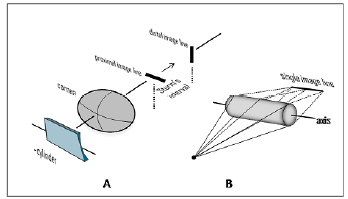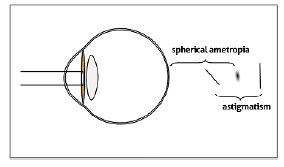Sidney Julio Faria e Sousa
DOI: 10.17545/eoftalmo/2018.0020
ABSTRACT
Once detected an astigmatic ametropia, it is possible to break it down in an astigmatic aberration and a spherical ametropia, address separately each of these elements and regroup them into spectacle lenses prescription. This aim is readily attainable by representing astigmatism by a cross cylinder and the spherical ametropia by the spherical equivalent of the refractive error.
Keywords: Astigmatism; Refractometry; Refractive Errors.
RESUMO
Quando uma ametropia astigmática é detectada, é possível separar a aberração astigmática do erro esférico, para trabalharmos separadamente com cada um deles, e depois reagrupá-los em uma prescrição de óculos. Esse procedimento é facilmente realizado, representando o astigmatismo por um cilindro cruzado e o erro esférico pelo equivalente esférico da ametropia astigmática.
Palavras-chave: Astigmatismo; Refratometria; Erros Refrativos.
RESUMEN
Cuando se detecta una ametropía astigmática, es posible separar la aberración astigmática del error esférico, con el fin de que se trabaje en separado con cada uno de ellos, para luego reunirlos en una prescripción de gafas. Ese procedimiento se puede realizar fácilmente, representando el astigmatismo por un cilindro cruzado y el error esférico por el equivalente esférico de la ametropía astigmática.
Palabras-clave: Astigmatismo; Refratometría; Errores Refractivos;
INTRODUCTION
In its simplest form, refractive error is the condition in which the focus of the eye falls either behind or in front of the retina, thus generating a blurred image. Correcting a refractive error implies placing the focus of the optical system of the eye on the retina. The power and sign of the lens that fulfill this goal define the magnitude and nature of the error. Still, these considerations apply only to myopia and hyperopia, which belong to the group of spherical ametropias by being neutralized with spherical lenses. A more sophisticated group is the astigmatic ametropias, which includes eyes affected by astigmatic aberration. In these eyes, the refracted light generates for each object point two image lines perpendicular to each other and separated by a variable distance along the main axis of the optical system. Consequently, these eyes form, instead of one, two focused images for each object of observation. However, none of them reproduce faithfully the object of observation, because they are formed by an array of parallel lines, instead of points.1 In the center of the diopter interval between the two image lines (Sturm’s Interval) sits a circular blur known as the circle of least confusion(CLC) (Figure 1). The CLC has two peculiarities. The first is that images formed by it are made up of homogeneously scattered points (not lines), which reproduce the object of fixation in the best possible way for an astigmatic system. The second is that these images can be transported to the retina by means of spherical lenses like the foci of the spherical ametropias.1 These characteristics are relevant when considering that to neutralize the astigmatic ametropia, it is necessary to place the CLC on the retina with spherical lenses, aside from undoing the Sturm’s interval with cylindrical lenses.

Indeed, astigmatic ametropia is a spherical ametropia (spherical error) combined with an astigmatic aberration (Figure 2). The magnitude of the former is given by the diopter distance of the CLC to the retina, and the magnitude of the latter is given by the diopter extension of the Sturm’s Interval. This paper deals with how to separate these two components to reason separately with each of them and how to regroup them into the making of a conscious eyeglass prescription.

THE SPHERICAL EQUIVALENT OF THE ASTIGMATIC AMETROPIA
The spherical equivalent of astigmatic ametropia (SEa) is the optical power necessary to place the CLC on the retina. Therefore, it measures the spherical error embedded in the astigmatic ametropia. If the spherical equivalent is positive, we are dealing with hyperopia, and if it is negative, we are dealing with myopia, both affected with astigmatism. Given a spherocylindrical association, the SEa is calculated by adding half of the cylinder power to the power of the associated sphere. For example, given the association +4.0 × -2.0 cyl 180°, the spherical equivalent is

Thus, the above-described SEa corresponds to a hyperopic eye of + 3.0 D affected by an astigmatic aberration, which is neutralized with a 2.0 D cylinder whose axis is oriented at 180°. With this information, the practitioner can decide how much of the hyperopia he/she wants to prescribe, as long as the astigmatism correction does not alter the calculated spherical equivalent. In the next section, we will show how to prescribe astigmatism without changing SEa. To avoid confusion, in the example just given, +4.0 D is the value of the spherical lens that when combined with a cylindrical lens of 2.0 cyl 180° corrects the astigmatic ametropia. SEa (+3.0 D) is the lens that neutralizes the spherical error (places the CLC on the retina) generated by this combination.
CROSS CYLINDER AS A PROXY FOR THE ASTIGMATIC ABERRATION
As mentioned earlier, neutralizing the astigmatic aberration implies undoing the Sturm’s interval with cylindrical lenses, which can be achieved using one of the following three ways: by pulling the distal image line toward the proximal image line, by pushing the proximal image line toward the distal image line, or by doing both actions simultaneously. To maximize the effect of these actions, we must align the axis of the corrective cylinder with the image line to be moved. To undo the Sturm’s interval, acting on both image lines, we need to use a cross cylinder with the axis of the converging cylinder aligned with the distal image line and the axis of the diverging cylinder aligned with the proximal image line. Although the three procedures are equivalent in correcting the astigmatic aberration, only the third does not alter the position of the CLC relative to the retina and therefore does not alter the SEa. This property of a cross cylinder comes from the fact that it is a combination of two orthogonal cylinders of the same power and opposite sign. Single converging cylinders undo Sturm’s interval by pulling both the distal image line and the CLC closer to the cornea, whereas single diverging cylinders do so by pushing both the proximal image line and the CLC farther away from the cornea.
One of the distinguishing characteristics of the cross cylinder is the possibility of being transcribed as a spherocylindrical combination in which the power of the sphere is always one-half the power of the cylinder with inverted sign. For example, the lenses 0.5 × +1.0 cyl 180° and +0.5 × 1.0 cyl 45° are cross cylinders by definition. Another feature of the cross cylinder is that its spherical equivalent (average power) is invariably zero, which is precisely why it does not interfere with the spherical equivalent of the astigmatic ametropia. At this point, it is worth recalling that the spherical equivalent of a toric lens like the cross cylinder (SEt) has a different meaning from that of the spherical ametropia (SEa).1 However, it is extremely easy to convert a cylinder correction into a cross cylinder by merely choosing the cylinder and associating it with a spherical lens with one-half of its power and inverted sign. For example, the annotation of 2.0 cyl 180° when converted to a cross cylinder becomes +1.0 × 2.0 cyl 180°.
ANALYSIS AND SYNTHESIS OF THE ASTIGMATIC AMETROPIA
When an astigmatic ametropia is detected, it is possible to break it down in an astigmatic aberration and a spherical ametropia to address each of these elements separately and regroup them into an eyeglass prescription. This procedure is readily attainable by representing astigmatism by a cross cylinder and the spherical error by the spherical equivalent of the astigmatic ametropia.
To correct spherical ametropia, totally or partially, we should prescribe the entire or a part of the SEa . The decision on either option is based on the same criteria used for eyes with hyperopia or myopia. In hyperopia, for instance, the total amount of the refractive error is prescribed only in selected cases. More often, the correction is adjusted according to accommodative capability, oculomotor balance, and visual requirement. The same goes for the positive spherical equivalent. In myopia, the total prescription is the rule, as it does not make sense to keep visual acuity below its maximum level. The same reasoning applies to the negative spherical equivalent.
Regarding astigmatism, in principle, we seek to nullify it to achieve the best vision possible. However, there are situations where a partial prescription is indicated to reduce the distortion of the astigmatic correction. Whatever the decision made, the cylinder must be transcribed always in the form of a cross cylinder to avoid interference with the spherical equivalent previously determined. In short, the procedure involves the following steps:
1. Determine the refractive error of the eye.
2. Calculate the SEa to identify the nature and amount of spherical error.
3. Decide the amount of spherical error to be corrected.
4. Decide the amount of astigmatism to be corrected.
5. Transform the correction of astigmatism into a cross cylinder.
6. Add the correction of the spherical error to the cross cylinder.
At the end of these steps, we will have a prescription in which we know exactly the amount of the spherical error and the astigmatic aberration neutralized.
EXAMPLES
Case 1. An eye requires +4.0 × -3.0 cyl 180° for the total correction of its ametropia. The practitioner intends to prescribe  of astigmatism and leave the eye accommodating +1.0 D to infinity, claiming that both procedures facilitate the acceptance of the glasses. What prescription gives the best visual acuity to this eye considering the restrictions?
of astigmatism and leave the eye accommodating +1.0 D to infinity, claiming that both procedures facilitate the acceptance of the glasses. What prescription gives the best visual acuity to this eye considering the restrictions?
The SEa of the refractive error is  , which indicates that this eye has hyperopia. To make it hyperopic of only +1.0 D, which is the constraint imposed by the problem, we need to prescribe +1.5 D. The astigmatism to be corrected is
, which indicates that this eye has hyperopia. To make it hyperopic of only +1.0 D, which is the constraint imposed by the problem, we need to prescribe +1.5 D. The astigmatism to be corrected is  . This expression transcribed in the form of a cross cylinder corresponds to +1.0 × 2.0 cyl 180°. The addition of the intended correction of the spherical error with the cross cylinder leads to
. This expression transcribed in the form of a cross cylinder corresponds to +1.0 × 2.0 cyl 180°. The addition of the intended correction of the spherical error with the cross cylinder leads to

The prescription of +2.5 × -2.0 cyl 180° answers the question posed. As the prescription does not aim to fully correct the refractive error, it leaves a residual ametropia of +1.5 × -1.0 cyl 180° with the CLC placed at +1.0 D behind the retina, which is denoted by SEa = +1.0 D. The residue is calculated by subtracting the intended prescription from the refractive error, as follows:

Vision is not as clear as that offered by total correction of the aberration because of residual astigmatism. We consider Case 1 as having hyperopic astigmopia. (astigmatism + hyperopia).
Case 2. An eye needs -5.0 cyl 180° for the full correction of its ametropia. The practitioner intends to prescribe  of astigmatism claiming this facilitates the acceptance of the glasses. What is the prescription that gives the best visual acuity to this eye, taking into account the restriction?
of astigmatism claiming this facilitates the acceptance of the glasses. What is the prescription that gives the best visual acuity to this eye, taking into account the restriction?
The SEa of this refractive error is  . Zero indicates the absence of a spherical lens in the characterization of the refractive error correction. The first conclusion is that this eye is myopic because of the negative sign of SEa. Since the rule for myopia is to prescribe the full amount of ametropia to guarantee the best possible visual acuity, we will prescribe the whole SEa. With this procedure, we will place the CLC on the retina. On the other hand, the astigmatism to be prescribed is
. Zero indicates the absence of a spherical lens in the characterization of the refractive error correction. The first conclusion is that this eye is myopic because of the negative sign of SEa. Since the rule for myopia is to prescribe the full amount of ametropia to guarantee the best possible visual acuity, we will prescribe the whole SEa. With this procedure, we will place the CLC on the retina. On the other hand, the astigmatism to be prescribed is  . This expression when transcribed to a cross cylinder corresponds to +1.5 × -3.0 cyl 180°. The addition of the intended correction of the spherical error with the cross cylinder leads to
. This expression when transcribed to a cross cylinder corresponds to +1.5 × -3.0 cyl 180°. The addition of the intended correction of the spherical error with the cross cylinder leads to

The prescription -1.0 × -3.0 cyl 180° answers the question posed. As the prescription does not aim to fully correct the astigmatic aberration of 5.0 cyl 180°, it leaves a residual ametropia of +1.0 × -2.0 cyl 180° that hinders clear vision. By being a cross cylinder, this residue shows that the CLC is on the retina, as predicted. We consider Case 2 as having myopic astigmopia (astigmatism + myopia).
Case 3. An eye needs +2.5 × -5.0 cyl 180° for the total correction of its ametropia. The practitioner intends to prescribe the full correction of astigmatism without altering the accommodative effort that is being exerted by the eye. What is the prescription that fulfills the requested restrictions?
The SEa of this refractive error is  . The immediate conclusion is that the CLC is already on the retina since SEa equals zero. The eye is exerting no accommodating effort at infinity. We conclude that the SEa will have no influence on the prescription. By converting the full astigmatism to a cross cylinder, we obtain the expression +2.5 × -5.0 cyl 180°, which is the answer to the problem. In short, what the practitioner needs requires the full correction of the refractive error. We consider Case 3 as having neutral (or pure) astigmopia (astigmatism + emmetropia). A neutral astigmopia is always characterized by a cross cylinder.
. The immediate conclusion is that the CLC is already on the retina since SEa equals zero. The eye is exerting no accommodating effort at infinity. We conclude that the SEa will have no influence on the prescription. By converting the full astigmatism to a cross cylinder, we obtain the expression +2.5 × -5.0 cyl 180°, which is the answer to the problem. In short, what the practitioner needs requires the full correction of the refractive error. We consider Case 3 as having neutral (or pure) astigmopia (astigmatism + emmetropia). A neutral astigmopia is always characterized by a cross cylinder.
FINAL CONSIDERATIONS
The term astigmatism is ambiguous because it refers to either an ametropia or an aberration.1 On the other hand, an astigmatic ametropia can be construed as a spherical ametropia (or emmetropia) combined with an astigmatic aberration. The presence of a spherical ametropia within an astigmatic ametropia exacerbates the mental confusion with the terminology. The term astigmopia simplifies this matter by distinguishing the ametropia from the aberration and by providing a simple name for the astigmatic ametropia. Astigmopia admits the following three forms: hyperopic, myopic, and neutral. In this line of reasoning, the term astigmatism should be reserved to the optical aberration.
REFERENCES
1. Faria-e-Sousa SJ, Alves MR. Astigmatismo: Aberração ou Ametropia? eOftalmo. 2018;4(1):26-32. DOI: http://dx.doi.org/10.17545/eoftalmo/2018.0004

Funding: No specific financial support was available for this study
CEP: Not applicable
Disclosure of potential conflicts of interest: None of the authors have any
Received on:
June 4, 2018.
Accepted on:
August 13, 2018.